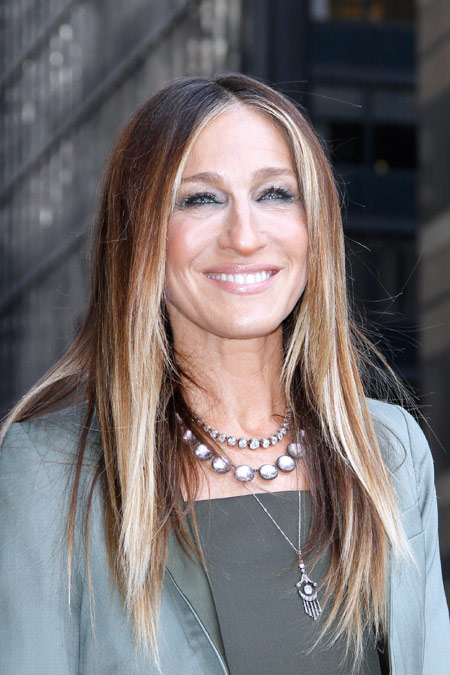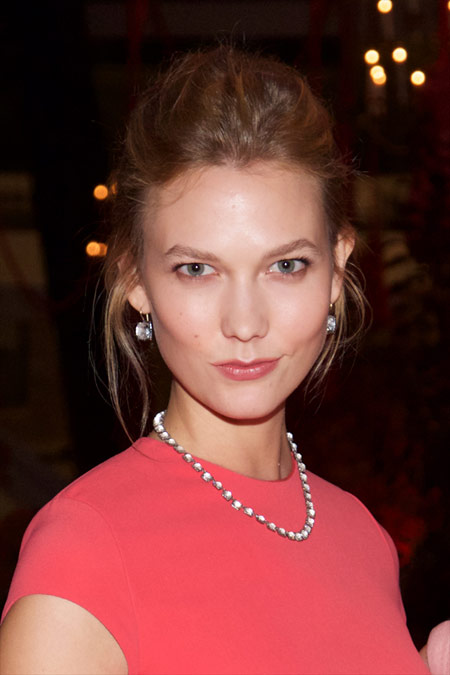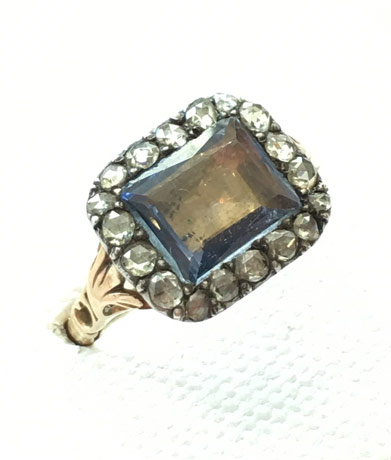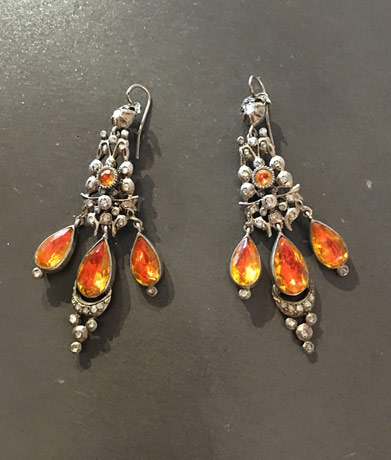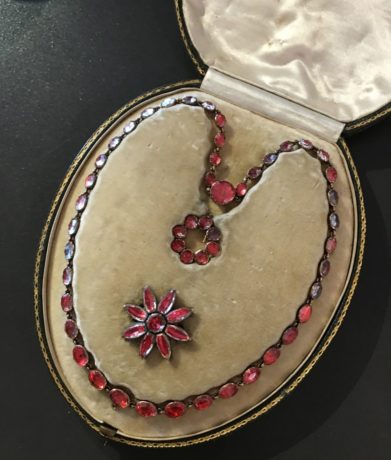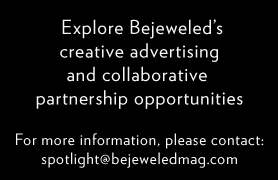Emily Satloff on Larkspur & Hawk and Georgian Jewelry
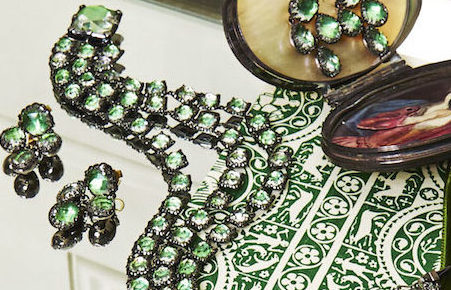
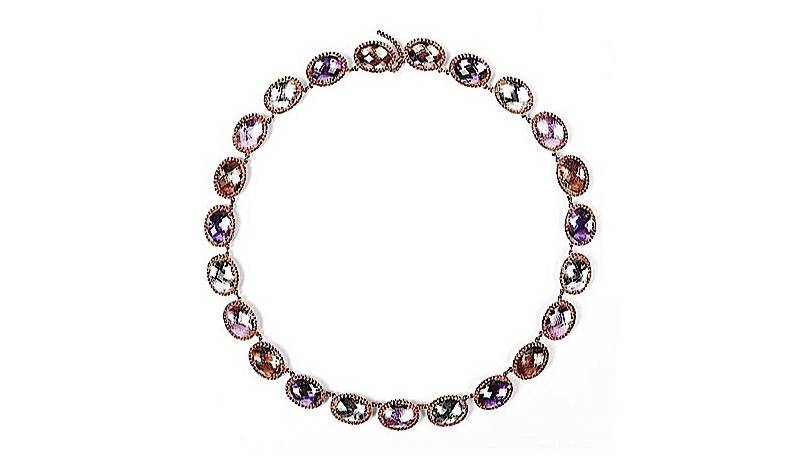
Larkspur & Hawk Lily rivière in rose gold washed sterling, white quartz and multi pink foils
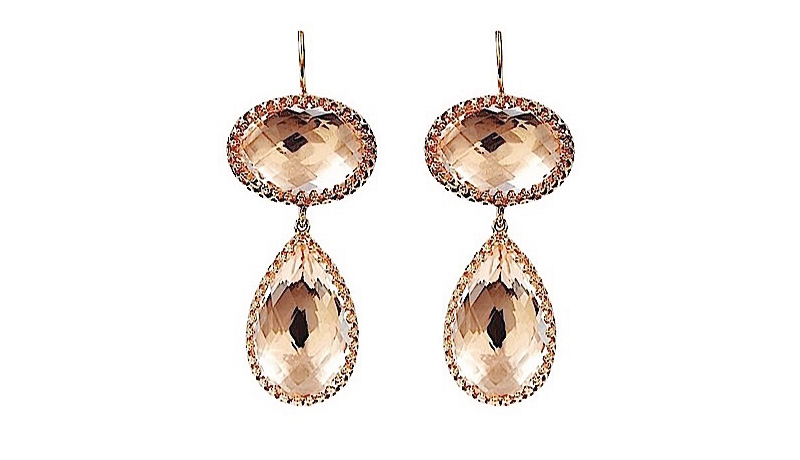
Larkspur & Hawk Lily Pendant earrings in rose gold washed sterling, white quartz and copper foil
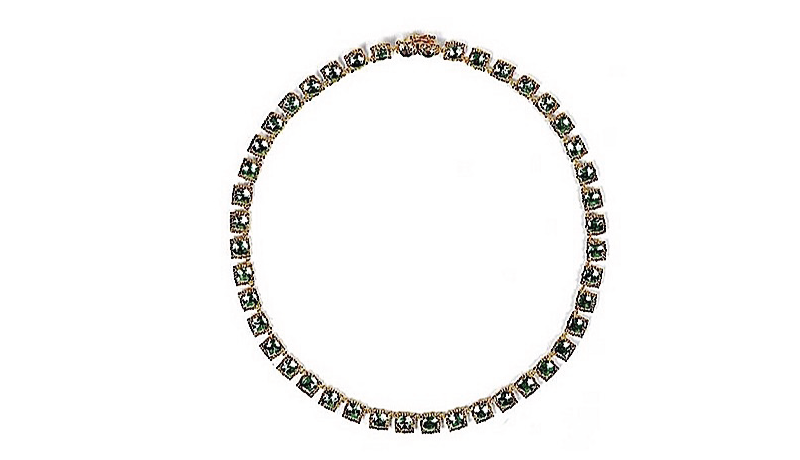
Larkspur & Hawk mini Bella rivière in gold washed sterling, white quartz and grass foil
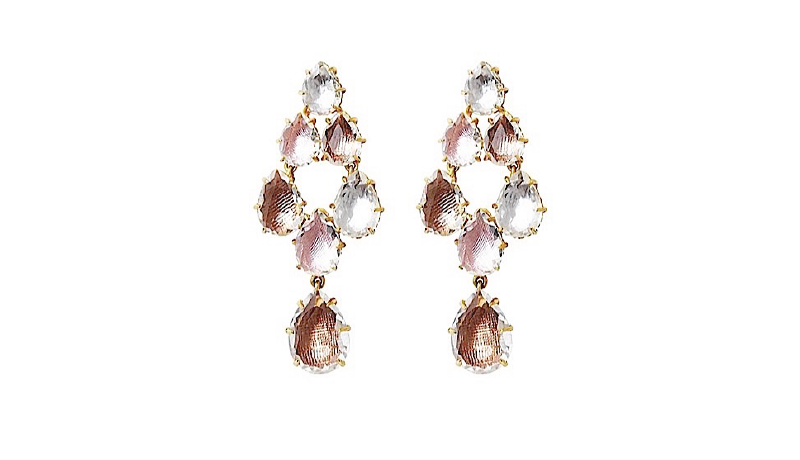
Larkspur & Hawk Caterina earrings in gold washed sterling, white quartz and multi fawn foils
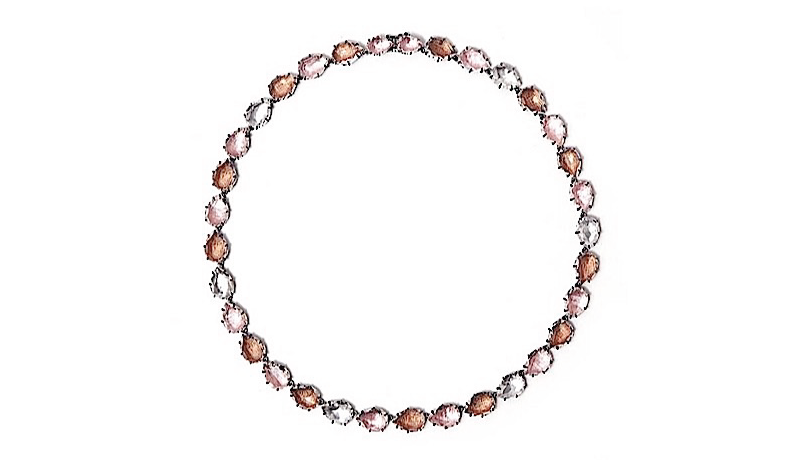
Larkspur & Hawk Caterina rivière in black rhodium washed sterling, white quartz and multi fawn foils
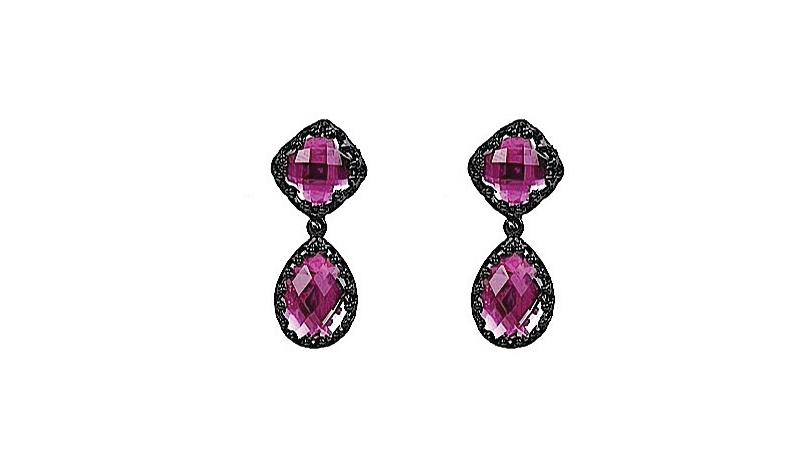
Larkspur & Hawk small Jane earrings in black rhodium washed sterling, white quartz and magenta foil
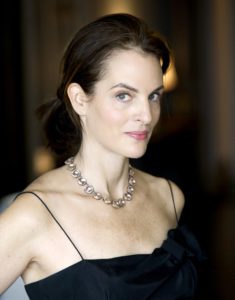
Emily Satloff
The first time I met Emily Satloff, the designer behind the comeback of color, rivière necklaces and the 18th century lost art of foiling the backs of stones, she was a well-known New York-based antique dealer whose display cases held all of the wonders and rarities of the Georgian Era. I was an avid collector of early pieces and, in addition to my career as an editor and writer, dabbled in antique dealing myself. I bought jewels from her, she from me, we traded pieces and stories and revealed our personal treasures to each other, both in awe of the craftsmanship that was 200 years old. In 2008 when I heard she was launching her own contemporary collection, Larkspur & Hawk, I was quite taken by the fact that she had found her own distinctive modern homage to a technique I love. She also showed the ability to render the historical pieces fashionable and enduring. With fans like Sarah Jessica Parker wearing her rivière in many a photo and after eight years of continuing to perfect her craft, I thought it was about time to sit down and have a heart to heart chat.
Emily: How long haven’t we seen each other?
Beth: Whose interviewing who?
Emily: Oh right, sorry—it must be 12 years—that was when I began to transition from dealing into designing, although I didn’t launch the collection until 2008.
Beth: Well, I’m glad we got that question out of the way.
Emily: Oh. I did it again- didn’t wait for the question. I’m just so excited to talk to someone who has the same passion as me for the 18th century jewelry. I would ask if you’re still collecting but I think we can talk about that later.
Beth: I was going to ask you the same thing but, yes, later in the interview. Let’s talk about Larkspur & Hawk and why and how the transition? And, by the way, it has been too long. I have been watching your career and seeing your jewels and wanting to do this since your first collection, but time has a way of speeding by.
Emily: It certainly does. The transition from what I admired so much about the 18th century pieces into creating something new felt very organic. I was looking at a Georgian piece and thinking about how no one had created foil-backed jewelry in that way- not for centuries. As you know, I wasn’t a designer, but I had these pieces in my head that I just wanted to try. I began playing with colored foil and faceted gemstones at my desk and thought about how pretty they started to look and different from what was out there in the modern fine jewelry market. I knew enough about repairs and the jewelers who could re-foil a stone or two that was damaged or had lost its color to know a bit about the process. I had first prototypes made, which were really just for me to see and wear and I was so surprised at how much I loved wearing them. After that there was no stopping me from developing the concept.
Beth: Can you tell us a bit about the Georgian foiled back jewelry to allow our readers to understand the technique?
Emily: It’s so strange explaining this to you because you know all about it, but here goes: The were flat cuts and rose-cuts that ranged from rock crystal to colored gemstones and diamonds (which were also in old mine cuts.) Stone cutting methods were not perfected back then so to enhance the color and camouflage the imperfections of the stones, the jewelers of the time used different colors of foil and closed the back, cut down settings This allowed the gems to glow by candlelight and to feature rich vivid hues.
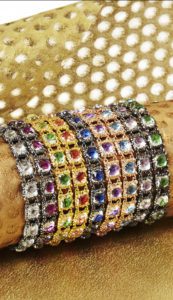
Larkspur & Hawk Bella Jeu de Paume bracelets
Beth: How do you translate the art when the stone cuts you are using have been perfected over the last 200 years?
Emily: For me it’s a way of playing with light, color and texture of various cut stones. It definitely offers an antique-inspired look but one that is more vibrant- even in the paler colors of say, a peach quartz. My gems pop and have an effervescence- and almost a shimmery effect.
Beth: Yes, when I look at the collection, it’s like the stones almost dance with the light- that they also have a dimensional feel to them.
Beth: When and how did you show your first collection?
Emily: It was truly a convergence of old and new. I was participating in an antique show at the New York Armory in 2008 and we were allowed to show modern pieces alongside antique and vintage pieces, I brought 10 pair of earrings and rivières and sold all of them. That was a turning point for me. I was more excited about selling my own creations and my heart was leading me down the path to grow the collection. As much as I loved the hunt and selling of antique pieces, I was the custodian of them for a short time- vetting them and passing them from a prior owner to the next. It was wonderful experience- the history is so fascinating with the stories and provenance- even those you conjure up in your mind about who it belonged to and how they might have lived. It was a truly intriguing time.
Beth: What was the next step or steps?
Emily: I started expanding on what sold and realized something that confirmed that I was making the right decision. Georgian jewelry had been around for centuries but if I was not here, if I didn’t exist, neither would the jewelry that I was designing. This part was life altering and my creativity really blossomed. But like all start-ups I grew in baby steps. When in the antique business, I used to say that wanted to sell enough so I could buy more. Now I was saying I wanted to sell enough so I could make more.
Beth: Do you feel your past careers all led you to what you are doing now?
Emily: Definitely. The early American decorative arts, the fact that I was a curator at the New-York Historical Society, and an antique dealer all inform what I am doing today, which is the career that is giving me the most joy. It’s in my heart—when I have a new design I am elated. Of course there are many times you have to make changes but to feel that good about what you do is so rewarding.
Beth: Since you are inspired by the past and feel that the jewelry from 200 years ago is unsurpassed, how do you keep it fresh? Do your feel your customers understand the difference between your jewelry and what has inspired you?
Emily: I will always be inspired by the past but I don’t want or believe my pieces ever look like reproductions. They are very modern in their execution. I mix geometric shapes such kite, hexagon, and pear shaped gems- all with foil backs. I also pavé with champagne diamonds to accent the more muted colors set in solid yellow, or yellow with an oxidized finish or rose gold.
Beth: Is there anything else that’s brand new for the upcoming season?
Emily: I have designed three collections that will launch for fall/holiday 2016. Be on the lookout come September. They are perhaps my most daring to date and were probably hardest to achieve. When I first started playing with this idea I thought back to the time of the Georgian bench jewelers and how they would pick up whatever stone was on the bench. Amethyst and white quartz- sure, let’s use them together. Cushion and pear shape- why not? Ironically, this might be the most antique inspired and current at the same time.
Beth: Was it hard to train salespeople and your customers as to why the collection has the price points it does and how painstaking the craftsmanship is?
Emily: Of course the women who understand and love period jewelry get it right away- and then there are those who we explain the whole process to and they are in awe. And then there are women who love modern jewelry who just become captivated by the look. But at first it was a bit of a difficult path.
Beth: Is there an age range for your customer?
Emily: The woman who buys, say, a pair of my earrings ranges from 15 to 80 years old but they just wear it differently. That’s why I have been so hesitant to use models on my website or in any advertising. The collection shouldn’t be geared to any one demographic.
Beth: Can you talk about selling your pieces at Fred Leighton? It seems like the perfect fit?
Emily: It’s so wonderful and also another phase that happened organically. The collection looks right at home with their antique jewelry and their own designed signature collection. And I don’t think the modern competes with the period or vintage pieces- I think they all co-exist. I also think that the woman who own a pair of foil backed Georgian earrings might not want to match to a Georgian rivière but would rather wear a modern version that coordinates, which offers an individualized look.
Beth: Yes, and one that doesn’t look like you are stepping out of a period film when you “mix things up a bit.” But what about customers who want one-of-a-kind pieces?
Emily: We can definitely customize pieces in the collection. But there is also something really gratifying about knowing you can replace a client’s earring if she lost one. With antiques, all you could do was make a pendant out of the other one. Or, the times when you have a customer come in, look at a Georgian necklace, go for a half hour walk to think about it and you see their face drop when they come back and someone else has bought it and they know they will never find it again. Now I can make the same or similar piece if something gets sold.
- Sarah Jessica Parker “Late Show with David Letterman” . (Photo by Donna Ward/Getty Images)
- Karlie Kloss; Photo Credit: Julie Skaratt
Beth: Sarah Jessica Parker among others is a real fan. How does that make you feel?
Emily: Wonderful. I love the way she gets it- the way she wears the rivière dressed up and really dressed down and with other necklaces. And I especially love when she reverses them- wearing them backwards.
Beth: Yes I’ve seen that in photos. It was truly impressive.
Meanwhile, I love that you’ve started to mix colors. It reminds me of the very rare, hard to find Georgian Harlequin pieces with the mix of many colors. Do you own any of those pieces?
Emily: No, but I love them and how daring they were for that time period- so bold without ever being overstated or too loud. Do you own any?
Beth: No, I did the walk around for a half hour and it was gone…It was the one good piece I’ve seen in many years- but I am definitely thinking of owning one of your modern interpretations.
Emily: Thank you. It’s funny but I still have a personal collection of Georgian jewelry. I still pine for those that I wish I hadn’t sold and those I wish I had bought. I still enjoy them and visit them but I don’t buy them anymore. I wear my own jewelry instead but I would never give up those superb examples of history. And you?
Beth: Oh we are definitely talking Georgian now! Yes, I have my collection still- I also have sold some pieces I really regret selling but definitely have the pieces I’ve had since last time we met, mostly rings and earrings and a few pendants. I still go to antique shows to cover them and yes, if something is really rare and I know it’s authentic, I will ultimately not let it slip away. Lucky for me– and all the women out there– when I decide on one of your rivières, I won’t ever miss out-as there will always be more than one!
Emily: And the collection will keep evolving as it has been. For the woman who takes that half hour to walk around, have a cup of coffee and a think, we will always have a pair of earrings, ring, pendant or rivière for her when she returns.
- some of Emily’s favorite Georgian pieces

